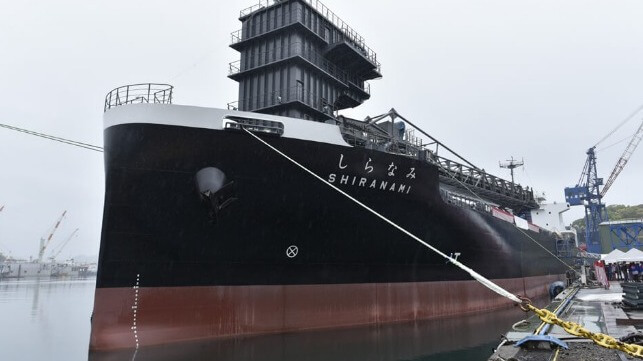NYK Coal Carrier Tests Navigation and Engine Automation Systems

Japan’s NYK Line took delivery today on a newly built domestic coal carrier which incorporates a new level of technology being used to advance the automation of the ship’s operations. The 8,600 dwt vessel, the Shiranami, is part of a government-funded R&D project that seeks to promote maritime industry consolidation and collaboration between shipbuilders, owners/operators, and technologies to increase the operating efficiency and competitiveness of the Japanese industry.
The maritime industry in Japan is confronting a range of challenges including a decreasing number of seafarers and aging of the existing workforce. The long hours required for seafarers are also a concern. The industry is looking to automation to help it addresses these trends.
The Ministry of Land, Infrastructure, Transport and Tourism (MLIT) launched a competition in 2021 to select a series of projects that it believed would help Japan's maritime industry to develop next-generation ship technology. MLIT highlighted the success that European competitors were having in system integration calling for Japanese shipyards and ship manufacturers to collaborate in order to survive international competition.
Four projects out of a total of nine were selected to develop elements of technology for automation and enhanced operating efficiency. One project focuses on navigation to lay the foundation for increasingly automated vessel navigation. A second project is for zero-emission shipping through the development of hydrogen fuel cells. Projects focusing on the coastal shipping sector seek to develop next-generation shipping by promoting engine monitoring technology and also new cargo handling systems.
The Shiranami, which was built at Honda Heavy Industries’ Saiki Shipyard, is 416 feet long and a sister ship to the Ushio, which was delivered in July 2022. By having an identical sister ship, the project has a baseline from which to compare the operations between the two ships.
The navigational systems installed on the new ship seek to improve the reliability of the information available on the bridge about surrounding vessels. The system integrates visual information from cameras as well as sensors which will help to inform the navigation plan and collision avoidance. The vessel is operating in what is being called crewed autonomous navigation and the results will be compared with operational data from the Ushio.
The engine system utilizes shore-based management systems that are monitoring to detect engine anomalies as well as a system that analyzes the operation to estimate the cause of anomalies. The system will contribute to safe operations and reduce the workload for the crew.
The new vessel will be operated by Asia Pacific Marine Corporation, a company affiliated with NYK. It is part of NYK’s service to provide a seamless link between ocean-going shipping and domestic coastal shipping. NYK Group is providing an efficient secondary transport network for the coastal trade.
Both ships are operating as part of a transport contract between NYK and Japanese power company JERA. They are loading coal from a relay station located in Tokyo Bay that receives international shipments. These coastal vessels transport the coal from the station to JERA’s Yokosuka Thermal Power Station located outside of Tokyo Bay. Another innovation incorporated into the ships’ design are hatch covers that can be kept closed during the discharging operations as a dust-prevention measure.
